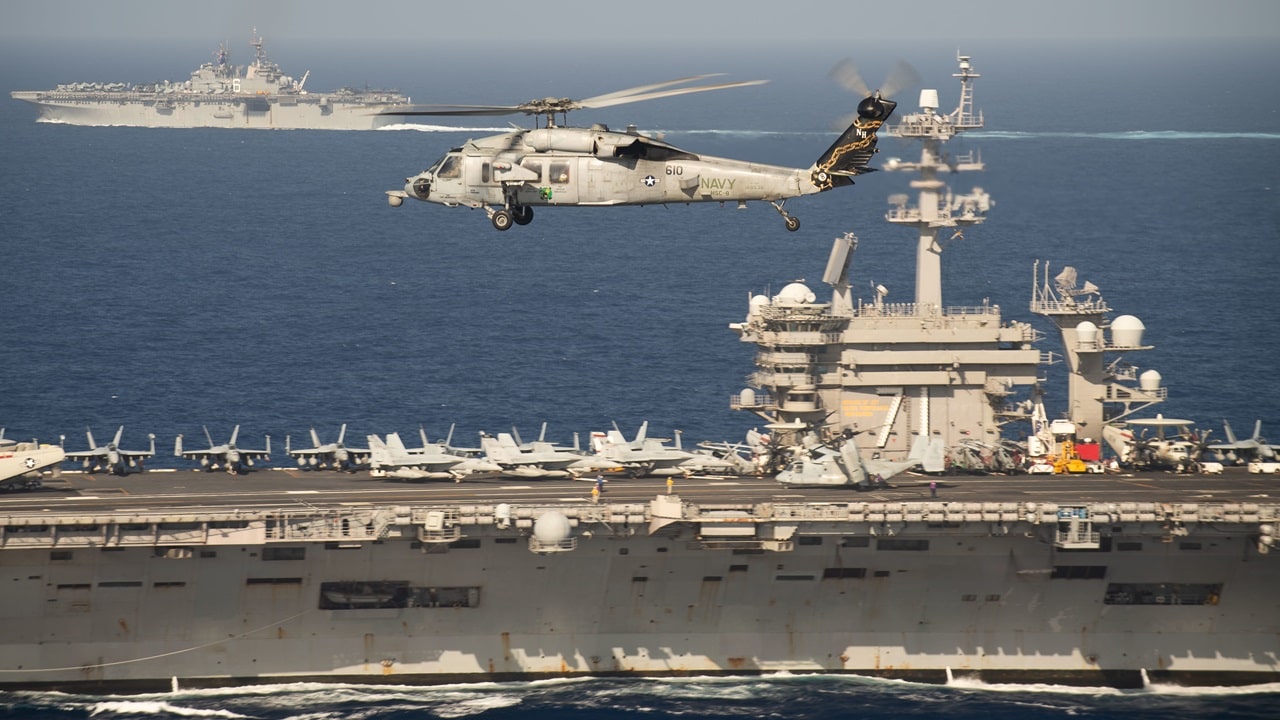USS Theodore Roosevelt: One of the Navy's Best Aircraft Carriers Ever
The USS Theodore Roosevelt is still going strong. Actually, the boat was just retrofitted to support F-35 Joint Strike Fighter operations.
USS Theodore Roosevelt, a Primer: Most Americans associate the name Theodore Roosevelt with the natural world, with adventure, and with supreme self-confidence.
Roosevelt, the 26th President of the United States, was also regarded as a hunter, a Rough Rider, a conservationist – and also an imperialist. So, the U.S. Navy’s decision to name one of its vaunted aircraft carriers after Theodore Roosevelt seems a fitting choice.
Actually, four U.S. Navy vessels have borne the Theodore Roosevelt name, while another three have borne Roosevelt.
Yet, the most significant of the seven Roosevelt vessels is the aircraft carrier USS Theodore Roosevelt – a nuclear-powered monster.
Barely Commissioned
The USS Theodore Roosevelt was commissioned in 1986 after being launched in 1984.
The Theodore Roosevelt is still in service today, nearly forty years later. Yet, despite the Theodore Roosevelt’s admirable service record, the ship almost never sailed at all. In fact, the program was cancelled not long after its inception, when then-President Gerald R. Ford axed the Theodore Roosevelt in favor of building two CVV type medium-sized conventional-powered carriers capable of launching V/STOL aircraft.
When Ford was beaten in his reelection campaign, some hoped that the incoming president would reinstate the Theodore Roosevelt. But incoming President Jimmy Carter, generally considered a dovish president, axed the Theodore Roosevelt. Actually, Carter vetoed the entire 1979 Fiscal year Department of Defense authorization bill because the authorization bill set aside funding for the Theodore Roosevelt.
Carter, who himself had once served in the U.S. Navy aboard multiple nuclear submarines, was opposed to funding yet another nuclear-powered aircraft carrier. Carter changed his mind only after Iranian students took U.S. embassy workers hostage in Tehran. The Iranian Hostage Crisis was perhaps the most significant event of Carter’s presidency – a watershed that increased Carter’s need for foreign troop deployment, and increased Carter’s need to appear strong on military-related issues.
Accordingly, Carter authorized funding for the Theodore Roosevelt in 1980. The carrier was finally laid down in 1981, about five years after Ford cancelled the project.
The ship was designed CVN-71, and given a fitting radio call sign: “Rough Rider,” which was the nickname of the volunteer cavalry-unit that Roosevelt commanded during the Spanish-American War.
A Modern Construction Process
The Theodore Roosevelt, like all modern carriers, is a floating city, capable of hosting five thousand or so people, at sea, indefinitely. Constructing something so grand is a feat. To construct the Theodore Roosevelt, builders tried something new: modular construction.

In modular construction, large portions of a vessel are constructed independently of one another. Then, the individually-built modules are hoisted into place and welded together. Hoisting the modules into place for the welding process requires the use of enormous gantry cranes, each capable of lifting 900 tons.
While perhaps not as impressive as the ship being built, the gantry cranes themselves are fascinating creations.
The use of modular construction worked well on the Theodore Roosevelt – so well that 16 months were shaved off the construction time. Ever since, the U.S. has used modular construction to build their aircraft carriers.
Once all the modules had been welded into place, the finished Theodore Roosevelt measured 1,092 feet long and displaced 104,600 tons. The fifth-of-a-mile-long-boat relied upon two Westinghouse A4W nuclear reactors and four steam turbines to drive four shafts, which propelled the Theodore Roosevelt’s towering propeller blades.
The ship’s propulsion system was capable of pushing the boat to speeds of 30-plus knots.

More impressive still, the Theodore Roosevelt, like all nuclear-powered Navy vessels, could operate indefinitely, up to 20-25 years at a time, with only food and supplies limiting the ship’s endurance.
The Theodore Roosevelt in Service
The Theodore Roosevelt was first deployed in late 1988, for a six-month patrol of the Mediterranean Sea. The 1980s concluded for the Theodore Roosevelt without much action. The 1990s picked up however, with the Theodore Roosevelt deployed to the Persian Gulf in January 1991 for the beginning of Operation Desert Storm.
The Theodore Roosevelt was an active participant in Desert Storm (aka the First Gulf War), launching over 4,000 sorties – the most of any aircraft carrier in the war. Over the course of the 4,000-plus sorties, aircraft launched from the Theodore Roosevelt are estimated to have dropped an estimated 4.8 million pounds of ordnance.
President Bill Clinton visited the Theodore Roosevelt in 1993, stopping aboard for several hours while the ship was loitering near the coast of Virginia. After the presidential visit, the Theodore Roosevelt spent much of the 1990s further deployed, participating in Operation Deny Flight, Operation Southern Watch, and Operation Deliberate Force.
The Theodore Roosevelt is still going strong. Actually, the boat was just retrofitted to support F-35 Joint Strike Fighter operations, suggesting that the Theodore Roosevelt will remain in service even as the Ford-class carriers, named for the man who once cancelled the Theodore Roosevelt, enter the fleet.
About the Author
Harrison Kass is the Senior Editor and opinion writer at 19FortyFive. An attorney, pilot, guitarist, and minor pro hockey player, Harrison joined the US Air Force as a Pilot Trainee but was medically discharged. Harrison holds a BA from Lake Forest College, a JD from the University of Oregon, and an MA from New York University. Harrison listens to Dokken.


